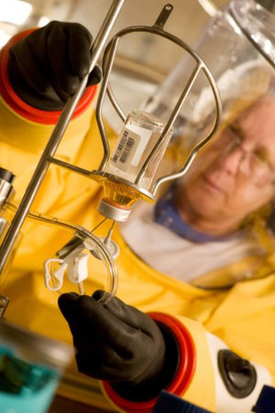Wickham Laboratories Editorial On Sterility Testing Published In EPM
We are pleased to announce that the following editorial article written by a member of staff at Wickham Laboratories has recently been published by European Pharmaceutical Manufacturer

Karl Barker, Head of Microbiology at Wickham Laboratories explains the challenges and solutions in sterility testing.
Medical devices or parenteral pharmaceuticals that are injected or implanted into the body are required to have a sterility test to confirm that there are no microorganisms present. The testing is governed by international standards eg USP, Ph Eur, JP, and ISO1-4.
There has been an increased focus on sterility testing recently given several high profile cases where medical products have been contaminated with microorganisms causing septicaemia and even death.
Sterility testing must be completed under strict aseptic conditions by well trained staff utilising documented verified procedures. The difficulty lies in that the test environment and test system are under a significant and constant microbial challenge. Used in combination, isolator technology and enclosed sterility test systems such as the industry standard Merck Millipore Steritest significantly reduce the risk of contamination during testing, but we must not become complacent and rely on technology alone.
There are two methods of sterility testing: membrane filtration and direct inoculation. With membrane filtration, product is filtered equally onto two sterile discs which are then washed and exposed to different broth media.
Direct inoculation involves a product being placed directly into a volume of broth and can only be used where filtration is not possible. In both cases the broth media is incubated for a period of 14 days after which the broths are rated as growth or no growth based on turbidity; no growth indicating sterility. Most parenteral products undergoing sterility testing are aqueous preparations which may be readily sampled and filtered requiring little in the way of special attention. However, not all pharmaceutical preparations are as simple to test.
The first category of difficult samples are those which filter slowly or those in which the filtration rate slows due to filter blockage. Samples prone to such filtration difficulties include products containing proteins or methylcellulose. Use of surfactants such as Tween or Triton x100 in the wash fluid may help as they lower interfacial tension and act by dispersing the agent. It is important to pre-wet the filter with the fluid and surfactant prior to sampling in order to minimise the potential for binding to the filter matrix. Additionally, warming the samples to reduce the viscosity may help with difficult products.
Antibiotic preparations have a tendency to bind to the filter making them difficult to wash from the filter matrix. It is essential in testing these samples to use low binding filters and incorporate Lecithin and Tween in the wash fluid to aid washing and provide a neutralising capacity to the test system. As larger volumes may distort the filter matrix, the maximum amount of wash fluid allowed on a 47mm filter is 500mL, usually delivered as five separate 100mL washes.
Pharmaceutical preparations which contain oils or fats are also a challenge but they may be rendered soluble by the use of isopropyl myristate (IPM). The IPM is sterilised by filtration and stored in sterile bottles until required. When IPM is used, the product is aseptically transferred into the IPM, mixed thoroughly, and then introduced to a dry membrane filter to facilitate more rapid filtration. Filtration is generally slow but once complete, wash fluid containing up to 5% Tween can be used to wash the IPM and product mixture from the membrane. Again, filtration is slow, but gentle swirling of the filter can help the process along. In this process, up to 5 x 100 mL washes may be required. For more difficult samples, warming the IPM and Tween wash fluid up to 37⁰C can aid the filtration process.
Another challenge that may arise in sterility testing is caused by the products which can impart a “haze” to the media, making it impossible to tell whether this is due to the sample or microbial growth. The pharmacopoeias recommend a subculture of this media to establish whether the growth is microbial or not. This additional testing requires at least another four days of incubation with a test now at least 19 days long.
In addition to these issues, the increasing level of sophistication in delivery devices may also present difficulties in testing. Devices such as prefilled syringes or powder cassettes for inhalers which fit neatly into the device often require multiple manipulations and are therefore a greater risk during sterility testing as the chance of microbial contamination is increased.
Obtaining a valid sterility test method requires significant time and effort in the method suitability stage of the procedure to ensure it is robust and repeatable thus reducing the potential for problems further down the line.
CONTACT
UK Export News
Wickham Laboratories Ltd
mail@wickhamlabs.co.uk
www.wickhamlabs.co.uk
+44 (0) 1329 226600
Sunday 26 April 2015 / file under Pharmaceuticals | Medical | Healthcare



